INTRODUCTION
The food additives such as the vitamins, the antioxidants or the antimicrobials, that are having certain bioregulating function in the human organism, are nowadays readily incorporated in new kinds of funcional foods interesting for the consumers of healty food products. Known by the name of Nutraceuticals, these new kinds of funcional food products are in the focus of the modern research of both the food engineers and the nutritionists, as well (Benkerroum, 2008; Mine et al., 2010). Partial glycerides of fatty acids and their derivatives are among the safest food emulsifiers approved by the Food and Drug Administration of the United States as direct food additives (Moonen and Bas, 2004; Hasenhuettl and Hartel, 2008). Those compounds present a group of nonionic surfactants with unique properties such as a high surface activity, a low toxicity and a good biocompatibility (Mladenoska, 2007). Additionally to the primarily emulsifying properties the monoglycerides has another characteristic that is very important for their use in emulsified food products, their antimicrobial activity (Deog Hwan and Marshall, 1994; Kabara and Marshall, 2005). Due to this very important property the utilization of these emulsifiers in food preservation and active packaging of food are becoming rapidly developing research areas nowadays (Han, 2003; Brody et al., 2008). The monolaurin is the active component of the food supplement that is known by its commercial name Lauricidin. Actually it is one of the active ingredients in human and coconut milk that are known for their beneficial effects on the human immune system (Liberman et al., 2006). There are many reports about evaluation of the activity of monoglycerides against some pathogenic and food spoilage bacteria (Mbandi et al., 2004, Skrivanova et al., 2006; Tokarskyy and Marshall, 2008, Batovska et al., 2009). However, there are not many papers about their antifungal activity. Jay et al., 2005, when investigating the susceptibility of meat products to spoilage caused by different microbial strains reported that the bacon and the cured hams that were smoked and/or brined are insusceptible to spoiladge by bacteria, but not to moldiness, especially to strains of Aspergillus, Alternaria, Fusarium, Mucor, Rhisopus, Botrytis and Penicillium. Thus, it seemed reasonable to investigate not only the antibacterial but also the antifungal activity of the monolaurin used as an additive in model meat sausages. In the present work the antifungal activity of the monolaurin was investigated by utilisation of two test microorganisms: the fungus Aspergillus niger MK-15 and the yeast Sacharomyces cerevisiae TMF. The critical fungicidal concentrations of monolaurin that would prevent the growth of the certain microbial strain were also determined. The comparison of the effects of the monolaurin and the most frequently used meat preservatives, the curing salt, and the table salt, was also performed. The effect of monolaurin on the sensory characteristics of the products was also studied. Several sensory characteristic such as: flavour, juiciness, tenderness, elasticity and overall acceptability were all investigated.
MATERIALS AND METHODS
Test microorganisms
The two microbial cultures used, Aspergillus niger MK-15and Saccharomyces cerevisiae TMF, were part of the Culture Collection of Microorganisms of the Faculty of Technology and Metallurgy in Skopje, R. Macedonia. The microorganisms were grown on Sabouraud agar slants. The pH value of the medium was adjusted to pH 5.6. All ingredients for the Sabouraud agar slants were purchased from Torlak, Belgrade, Serbia.
Preparation of the emulsified products
Model fresh emulsified sausages were prepared according to the process flow diagram presented by Toldrá and Reig, 2007. The meat used was a combination of beef and pork minced meat in a weight proportion 2:1. The Lauricidin (commercial product of monolaurin purchased from Ecological formulas (Concord, California, USA)) was added to the sausages in a concentration of 0.3, 0.675 and 1.36 g per 100 g sausage. The nitrite salt (NaNO2) and the table salt (NaCl) were added in a concentration of 0.016 g/100 g sausage and 2 g/100 g sausage, respectively. Ascorbic acid and citric acid were added in concentrations of 0.2 g per 100 g sausage. Mixture of spices had following composition: NaCl 1.25%, Vegeta spice mixture 3.65% and paprika 1.46%. All additives were added separately. The sausages were drained and then pasteurized at the temperature of 80 °C (72 °C in the center of the sausage) in duration of 30 min.
Sensory analysis
A 9-point hedonic scale (9-like extremely, 1-dislike extremely) was used to evaluate sensory attributes like: flavor, juiciness, tenderness, elasticity and overall acceptability according to Lyon and Lyon (2001). The appearances of the fresh sausage containing 0.3 g monolaurin and of the drained sausages with monolaurin and nitrite salt are presented at the Figure 1.
Inoculation of the sausages
The pasteurized sausages were inoculated by 10 mL portions of cultures from A. niger MK-15 and S. cerevisiae TMF, both with concentration of approximately 107 cfu/mL. The infected sausages were kept 72 h on 28 °C. Cell enumeration of the sausage samples was performed by standard plate counts and calculated as a number of colony forming units on a gram sample. The samples were taken from the inside of the sausages (without the skin) and from the whole sausage body (including the skin of the sausages). 25 g of sample was diluted in 225 mL of water and homogenized. 1 mL of this solution was inoculated on a Petri Dish containing 10 mL Sabouraud agar. The agar plates were incubated at 30 °C during 5 days. All examined samples were diluted 103 times.
Determination of the minimal fungicidal concentration (MFC)
Different amounts of monolaurin that corresponded to the concentrations of 1000, 750, 500, 400, 300, 200, 100, 50 and 0 mg/L were added to individual doses of Sabouraud agar, which were then autoclaved at 121 °C for 35 minutes. After cooling, the solutions were dosed aseptically in 20 mL quantities into Petri Dishes (150x25 mm). A 1 mL portion of thecultures having a certain concentration (≈107/mL) were dosed onto the surface of the solidified agars enriched with a monolaurin. They were incubated for 7 days at 28 °C. The MFC values for the A. niger MK-15 and for the S. cerevisiae TMF cultures corresponded to the lowest concentration of monolaurin that completely disabled the growth of the certain microorganism i.e. no visible growth on the Petri Dishes could be detected.
 Fig. 1.
Fig. 1. The appearance of the a) fresh sausage with 0.3 g monolaurin (the orange scent of the sausage color could be spotted) and b) of the drained sausages with monolaurin (on the left) and with the nitrite salt (on the right). The typical pink color of the sausages with the nitrite salt could easily be noticed.
Results and Discussion
Antifungal activity towards the Saccharomyces cerevisiae TMF strain
The appearance of the sausage infected by S. cerevisiae TMF and the enumeration of the yeast on a Petri Dish is presented at the Figure 2.
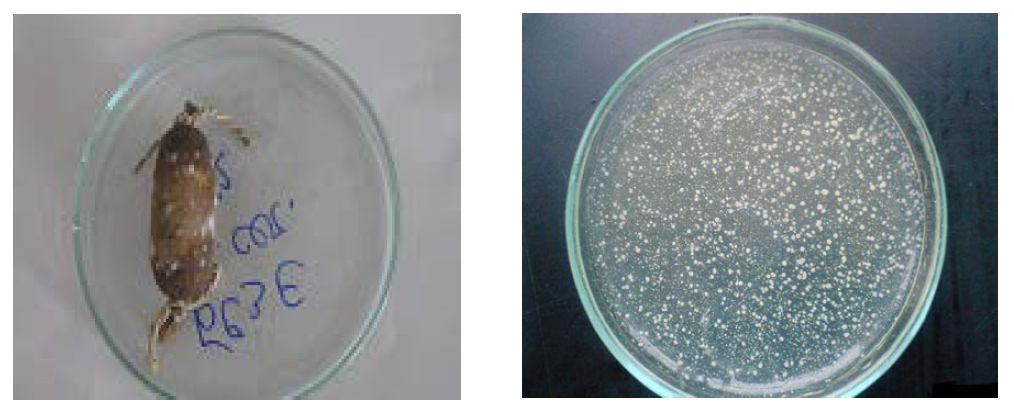 Fig. 2.
Fig. 2. The appearance of the surface of the infected sausage (left) and cell enumeration of the yeast on a Petri Dish (right).
The results achieved form the enumeration of the total cell counts are presented in the Table 1.
Table 1. Cell enumeration of the sausages with and without added monolaurin, infected by the yeast S. cerevisiae TMF
Sausage formulation |
The total cell count of
S. cerevisiae TMF of the inside of the sausage
(7.0 log10 cfu/g)
|
The total cell count of
S. cerevisiae TMF of the whole sausage
(7.0 log10 cfu/g)
|
|
|
|
|
|
Curing salt (NaNO2)
|
25.0
|
45.0
|
|
Table salt (NaCl)
|
90.0
|
150.0
|
|
Monolaurin
|
45.0
|
70.0
|
|
Without monolaurin
|
100.0
|
300.0
|
From the results presented in the Table 1 it can be noticed that both samples, the one taken from the inside of the sausages, as well as the one taken from the whole body of the sausages, infected by S. cerevisiae TMF, had lower value for the total cell count when contained the monolaurin as a food additive, compared to the samples without monolaurin in their composition. But interestingly, the curing salt had more pronounced inhibitory effect on the strain S. cerevisiae TMF than the monolaurin had. Thus, the total cell count enumerated from the samples taken from the inside of the sausages cured with NaNO2 salt was 25x7.0 log10 cfu/g and was even 1.8 times lower than the total cell count of the inside of the sausages with monolaurin. The curing salt had more than 3 times higher antifungal effect than the table salt, when calculated on the basis of the samples taken from the whole body of the sausages. In the present work, an attempt for quantification of the antifungal effect of the monolaurin on the S. cerevisiae TMF strain was done. As a parameter that would serve to this purpose, the minimal fungicidal concentration (MFC) of monolaurin that would result in a complete inhibition of the growthof S. cerevisiae TMF, was used. The results are presented in the Table 2.
Table 2. Minimal fungicidal concentrations (MFC) of some monoglycerides necessary for a complete inhibition of the growth of S. cerevisiae strains
MFC value in media containing different partial glycerides |
Saccharomyces cerevisiae
|
Reference
|
|
Media with monolaurin
|
>1000 mg/L
|
This study *1
|
|
Media with monolaurin
|
>750 mg/L
|
Ruzicka et al.*2
|
|
Media with monocaprilin
|
150 mg/L
|
Ruzicka et al.*2
|
From the results presented in the Table 2 it is obvious that the minimal fungicidal concentration of monolaurin for the S. cerevisiae TMF strain was very high and unidentified for values below 1000 mg/L. Similarly, when Ruzicka et al., 2003, were investigating the minimal inhibitory concentration of monolaurin on the S. cerevisiae 8191a strain belonging to the Czech Collection of Microorganisms, could not determine its value for the concentrations below 750 mg/L. Unlike of monolaurin, the minimal inhibitory concentration of monocaprilin for the Saccharomyces cerevisiae 8191a strain has been reported to be as low as 150 mg/L.
Antifungal activity towards the Aspergillus niger MK-15 strain
The appearance of the fungus isolated from the surface of the infected sausage that did not contain monolaurin and the appearance of the infected sausage are presented at the Figure 3.
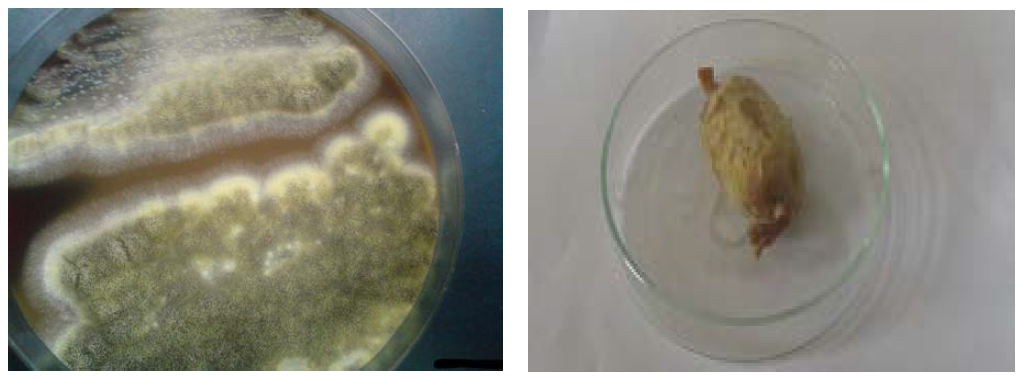 Fig. 3.
Fig. 3. Appearance of: the fungus
A. niger MK-15 isolated from the surface of the infected sausage that did not contain monolaurin (left) and the whole infected sausage (right)
The results for the cell enumeration are shown in the Table 3.
Table 3.Comparison of the antifungal effect of different compounds used as food additives in model pasteurized sausages towards the fungal strain A. niger MK-15
|
Sausage formulation
|
The inside of the sausage
infected by the fungus
A. niger MK-15
(7.0 log10 cfu/g)
|
The whole sausage infected by the fungus
A. niger MK-15
(7.0 log10 cfu/g)
|
|
Monolaurin
|
3.00
|
15.0
|
|
Curing salt (NaNO2)
|
8.50
|
30.0
|
|
Table salt (NaCl)
|
90.0
|
100.0
|
|
Without additives
|
100.0
|
250.0
|
As can be noticed from the results presented in the Table 3, the food emulsifier monolaurin, showed an excellent antifungal effect and its use resulted in a very low value of the total cell count of A. niger MK-15 of only 3х7.0 log10 cfu/g, calculated on the base of the inside of the sausages, and only 15x7.0 log10 cfu/g, calculated on the base of the whole sausages. These values were even more than 33 times and more than 16 times lower compared to the total cell count of 100x7.0 log10 cfu/g, for the inside, and 250х7.0 log10 cfu/g, for the whole sausages that did not contain any of the mentioned additives. The curing salt had also a very good preserving effect and enabled lower contamination of the sausages for about 12 times, calculated for the inside and more than 8 times, calculated on the base of the whole sausages. The table salt did not show too strong preserving effect. It is obvious that the monolaurin had much stronger antimicrobial effect towards the fungus A. niger MK-15, than it had towards the yeast S. cerevisiae TMF strain. This effect was even 15 times stronger when calculated on the base of the inside of the sausages and 4.7 times stronger, when calculated on the base of the whole sausage body. The quantification of this excellent antifungal effect was performed by determination of the minimal fungicidal concentration (MFC) of monolaurin in the growth media of the fungus A. niger MK-15. The results are presented on the Figure 4.
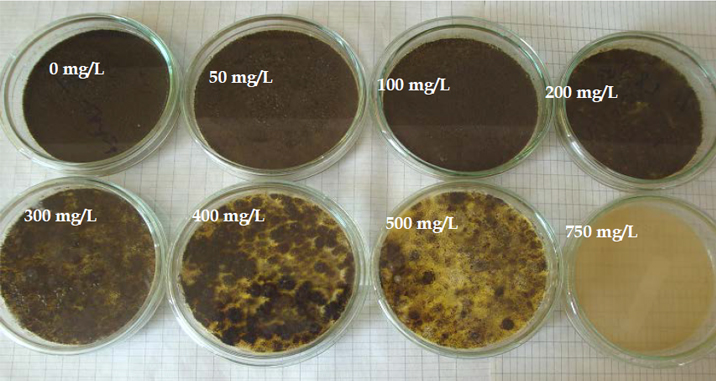 Fig. 4.
Fig. 4. Determination of the MFC value for the
A. niger MK-15 strain
From the results presented on the Figure 4, it is obvious that the cell density of the culture grown on the media containing the monolaurin in gradually increasing concentrations is inversely proportional to the concentration of the monolaurin in the medium. Thus, the cell density at the concentrations of monolaurin higher than 500 mg/L were very low and no visible growth could be detected at the concentrations of monolaurin of 750 mg/L and 1000 mg/L. So, the minimal inhibitory concentration for this fungal strain was determined to be 750 mg/L.
Besides the minimal inhibitory concentration, in the present work the radial growth of the fungus was also determined. Sabouraud agar with varied concentrations (200 mg/L, 500 mg/L, 750 mg/L and 1000 mg/L) of monolaurin and an agar free of monolaurin, were used as media for determination of the radial growth of
A. niger MK-15 (culture was diluted 106 times and was only 10 cfu/mL). The results are presented on the Figure 5.
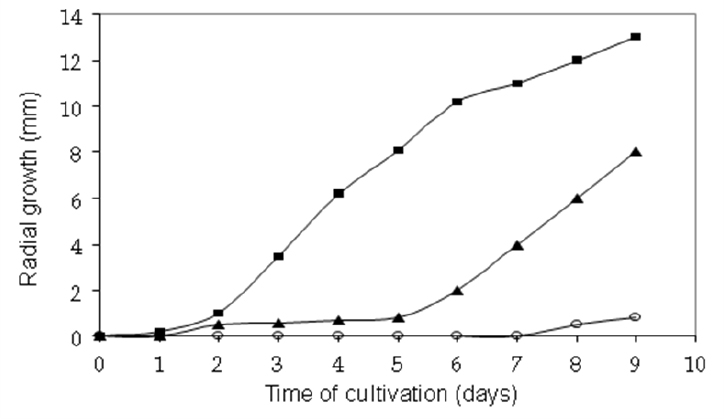 Fig. 5.
Fig. 5. The radial growth of the fungus
A. niger MK-15 on the media containing monolaurin in concentrations of 200 mg/L (▲), 500 mg/L (○) and on a control media without monolaurin (■).
As it can be seen at the Figure 5, the radial growth of the fungus was strongly inhibited in the media containing monolaurin in their composition. The radial growth on the medium containing 200 mg/L monolaurin was delayed for 4 days compared to the radial growth of the fungus on the monolaurin free medium. Thus the value for the radial growth of A. niger MK-15 on the medium free of monolaurin was 8 mm at the 5th day of the incubation and the same value for the radial growth was reached even at the 9th day on the medium containing 200 mg/L of monolaurin. Higher concentrations than 500 mg/L of monolaurin almost completely inhibited the growth of the fungus, and the radial growth on this media could not be determined during the period of cultivation of 10 days.
That the monolaurin could reduce the radial growth of the fungus A. niger is not a new statement. Thus, Řihakova et al., 2002, were investigating the effect of monolaurin and several other monoglycerides synthesized from coconut oil on the fungus A. niger DMF 0801 and found out that the radial growth was inhibited completely at the concentrations of monolaurin of 0.5 mg/mL and higher.
It was interesting to see if the morphology and the reproductive ability of the fungus A. niger MK-15 could be affected by the antimicrobial action of monolaurin, so another experiment was performed in the present work. Namely, the effect of the monolaurin on the sporulation ability of this fungus was investigated. The culture material from the infected sausages that contained monolaurin was inoculated on a freshly prepared medium that did not contain any inhibitory compound and was microscopically examined. The results are presented at the Figure 6. As can be seen at the micrographs the emulsifier had a very pronounced effect on the morphology of the mycelium and on the appearance of the fruiting structures, in generally. The culture isolated from the sausages that did not contain monolaurin had normal morphology of the fruiting structures, compact hyphe and dense conidia chains (Figure 6 (1)). On the contrary, the conidia of the culture isolated from the sausages that contained the monolaurin, after incubation of 48 h ware almost empty and with a deformed structure (Figure 6 (2)). Even more pronounced was the effect of the emulsifier on the culture incubated for 72 h and more. The fruiting structure of the fungus was entirely deformed and the conidia were completely empty (Figure 6 (3)).
 Fig. 6.
Fig. 6. Appearance of the healthy hiphas of
A. niger MK-15 in the monolaurin free media. (2) Deformed conidia of
A. niger MK-15 isolated from the media with monolaurin after 48 h of incubation. (3) Completely disorganized fruiting structure of
A. niger MK-15 with almost empty conidia at the 72 h of incubation in the media with monolaurin.
Similar results for the effect of monolaurin on spore germination were reported byŘihàkovà et al., 2002, when this monoglyceride was the most successful inhibitor of spore germination of the A. niger DMF 0801 strain among all examined monoglycerides and no spore germination was detected at the concentrations higher than 0.5 mg/mL.
There are many opinions about the mechanism of the action of monolaurin on the microbial cell. Some authors speculate that the fatty acid esters might affect the amino acid uptake through the microbial cell wall by altering its permeability (Kabara and Marshall, 2005) or to destroy the normal cytoplasmatic membrane due to their surfactant activity (Zang and al., 2007). Some authors have hypothesis that the monoglycerids and the fatty acids affect the microbial cell by acidifying the cellular surrounding (Marilyn et al., 2007). In generally authors are agreed that the monoglycerides affect the metabolism of the microorganisms on one way or on another.
Sensory characteristics
Several sensory characteristics such as flavor, juiciness, tenderness, elasticity and overall acceptability were all evaluated. The results for the flavor and the ovelarall acceptability are presented at the Figure 7. The sausages containing Lauricidin in a concentration of 0.675 g/100 g sausage showed good properties. It showed high scores for yield and elasticity, moderate values for tenderness and juiciness and moderate overall acceptability. However, used in high concentration it gave the sausage some off flavour: soapy taste and smell (Figure 7).
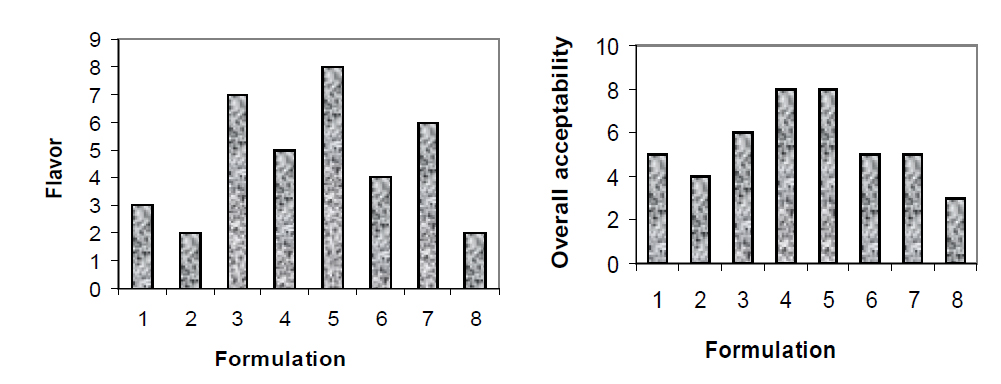 Fig. 7.
Fig. 7. Sensory characteristics of the model pasteurized sausages prepared containing different food additives:
1. 0.675% monolaurin,
2. 1. 36% monolaurin,
3. NaCl,
4. NaNO2,
5. mixture of spices,
6. ascorbic acid,
7. citric acid and
8. additive free (the control sausage)
CONCLUSIONS
The food additive monolaurin has shown a strong antifungal activity by causing a prolonged inhibitory influence on the vegetative cells as well as on the fruiting structure of the fungus. Thus, it could be very successfully used in meat emulsified products and give the product an attribute of healthy functional food, where it can prolonged the shelf life of the products and prevent their spoilage, primarily from mouldiness. However, the monolaurin should be used in low concentrations and in combination with some other food additives and spices that would mask its soapy taste and smell.
CKNOWLEDGEMENTS
The authors would like to thank to the Faculty of Technology and Metallurgy, the Institute for Preventive Medicine in the General City Hospital “8th of September” in Skopje and to the Institute for Health Protection in Stip, R. Macedonia for all the help given during the research that is now a part of this work.
Download full article PDF
 DOWNLOAD PDF
DOWNLOAD PDF
 Fig. 1. The appearance of the a) fresh sausage with 0.3 g monolaurin (the orange scent of the sausage color could be spotted) and b) of the drained sausages with monolaurin (on the left) and with the nitrite salt (on the right). The typical pink color of the sausages with the nitrite salt could easily be noticed.
Fig. 1. The appearance of the a) fresh sausage with 0.3 g monolaurin (the orange scent of the sausage color could be spotted) and b) of the drained sausages with monolaurin (on the left) and with the nitrite salt (on the right). The typical pink color of the sausages with the nitrite salt could easily be noticed. Fig. 2. The appearance of the surface of the infected sausage (left) and cell enumeration of the yeast on a Petri Dish (right).
Fig. 2. The appearance of the surface of the infected sausage (left) and cell enumeration of the yeast on a Petri Dish (right). Fig. 3. Appearance of: the fungus A. niger MK-15 isolated from the surface of the infected sausage that did not contain monolaurin (left) and the whole infected sausage (right)
Fig. 3. Appearance of: the fungus A. niger MK-15 isolated from the surface of the infected sausage that did not contain monolaurin (left) and the whole infected sausage (right) Fig. 4. Determination of the MFC value for the A. niger MK-15 strain
Fig. 4. Determination of the MFC value for the A. niger MK-15 strain
 Fig. 5. The radial growth of the fungus A. niger MK-15 on the media containing monolaurin in concentrations of 200 mg/L (▲), 500 mg/L (○) and on a control media without monolaurin (■).
Fig. 5. The radial growth of the fungus A. niger MK-15 on the media containing monolaurin in concentrations of 200 mg/L (▲), 500 mg/L (○) and on a control media without monolaurin (■). Fig. 6. Appearance of the healthy hiphas of A. niger MK-15 in the monolaurin free media. (2) Deformed conidia of A. niger MK-15 isolated from the media with monolaurin after 48 h of incubation. (3) Completely disorganized fruiting structure of A. niger MK-15 with almost empty conidia at the 72 h of incubation in the media with monolaurin.
Fig. 6. Appearance of the healthy hiphas of A. niger MK-15 in the monolaurin free media. (2) Deformed conidia of A. niger MK-15 isolated from the media with monolaurin after 48 h of incubation. (3) Completely disorganized fruiting structure of A. niger MK-15 with almost empty conidia at the 72 h of incubation in the media with monolaurin. Fig. 7. Sensory characteristics of the model pasteurized sausages prepared containing different food additives: 1. 0.675% monolaurin, 2. 1. 36% monolaurin, 3. NaCl, 4. NaNO2, 5. mixture of spices, 6. ascorbic acid, 7. citric acid and 8. additive free (the control sausage)
Fig. 7. Sensory characteristics of the model pasteurized sausages prepared containing different food additives: 1. 0.675% monolaurin, 2. 1. 36% monolaurin, 3. NaCl, 4. NaNO2, 5. mixture of spices, 6. ascorbic acid, 7. citric acid and 8. additive free (the control sausage)
 JOURNAL TOOLS
JOURNAL TOOLS


 INSTITUTE
INSTITUTE